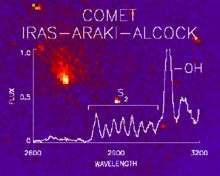Comet IRAS–Araki–Alcock


Comet IRAS–Araki–Alcock (formal designation C/1983 H1, formerly 1983 VII) is a long-period comet that, in 1983, made the closest approach to Earth, about 0.0312 AU (4,670,000 km; 2,900,000 mi), of any comet in 200 years; only Lexell's Comet, in 1770, and 55P/Tempel-Tuttle, in 1366, are thought to have come closer.[1][2] (The small comet P/1999 J6 (SOHO) passed about 0.01 AU (1,500,000 km; 930,000 mi) from Earth on 1999-Jun-12.)[3]
The comet was named after its discoverers – the Infrared Astronomical Satellite and two amateur astronomers, the highly respected George Alcock of the United Kingdom and Genichi Araki of Japan (both men were schoolteachers by profession, although Alcock was retired). Alcock had made his discovery simply by observing through the window of his home, using binoculars.[4][5]
During the closest approach the comet appeared as a circular cloud about the size of the full moon, having no discernible tail, and shining at a naked eye magnitude of 3-4. It swept across the sky at an incredible speed of some 30 degrees per day.
It is a long-period comet, with an orbital period of around 964 years, and is the parent comet of the minor Eta Lyrid meteor shower.[6] This shower's radiant lies between Vega and Cygnus and produces 1 or 2 meteors an hour in mid-May with a peak between May 9 and May 11.
References
- ↑ "Closest Approaches to the Earth by Comets". Minor Planet Center. Retrieved 2012-06-28.
- ↑ "JPL Close-Approach Data: C/1983 H1 (IRAS-Araki-Alcock)". 1983-10-04 last obs (arc=160 days). Retrieved 2012-06-28.
- ↑ "JPL Close-Approach Data: P/1999 J6 (SOHO)". 2010-04-22 last obs (arc=10.9 yr; JFC). Retrieved 2012-06-28.
- ↑ 'Obituary of George Alcock' BBC News, 21-12/2000
- ↑ 'Outbreak of Comet Fever', TIME Magazine, 23-05-83. "I've discovered a wonderful star," commented Araki, "Now I've got to discover a wonderful wife."
- ↑ 'Eta Lyrids', Meteor Showers Online, accessed 21-11-08